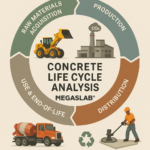In the construction industry, the search for sustainable building materials is increasingly important. As we grapple with the realities of global warming and resource depletion, the concrete industry is turning its attention to innovative solutions. One such solution is green concrete, a material that promises not only strength and durability but also a significantly reduced environmental footprint. This article delves into the world of green concrete, exploring its benefits, its role in sustainable construction, and how MEGASLAB is championing its use.
Understanding Green Concrete
Green concrete, often referred to as “environmentally friendly concrete” or “eco-friendly concrete,” is a type of concrete produced using waste or residual materials such as foundry sand and waste plastic as at least one of its components, or it’s concrete that retains an overall lower environmental impact over its lifecycle compared to conventional concrete. The primary difference between traditional and green concrete lies in the materials used in their manufacturing process.
Traditional concrete is typically composed of cement, water, and aggregates like sand and gravel. Cement production, however, is known for being a highly carbon-intensive process, and a significant source of carbon dioxide emissions. The cement industry contributes to around 8% of global carbon emissions.
In making green concrete, part or all of the cement is replaced with industrial by-products like fly ash from coal power plants, blast furnace slag, and silicon dioxide. These supplementary cementitious materials, which would otherwise end up in landfills, not only give green concrete its environmentally friendly label but also contribute to its improved mechanical properties.
Here’s a comparison of the components:
| Component | Traditional Concrete | Green Concrete |
|---|---|---|
| Cement | Ordinary Portland Cement | Partially replaced with industrial by-products like granulated blast furnace slag |
| Aggregates | Natural aggregates like sand and gravel | Can be partially replaced with recycled concrete aggregate |
| Water | Standard use | Reduced usage through admixtures |
By using industrial waste materials and lessening the need for virgin raw materials, green concrete structures offer a low maintenance surface and a long life cycle, aligning with global efforts to combat climate change. This approach in the production process of green concrete promotes circular economy principles in the cement industry.
The Environmental Impact of Green Concrete Compared With Conventional Concrete
Concrete, the most widely used construction material globally, has a significant environmental footprint. Traditional concrete production contributes to carbon emissions, with the majority of these emissions resulting from cement kilns. Moreover, the extraction of raw materials for concrete production often leads to habitat destruction and biodiversity loss. Learn more about the environmental challenges of traditional concrete by reading about why concrete can be bad for the environment and the importance of seeking sustainable alternatives.
In contrast, green concrete offers a more sustainable alternative. By incorporating waste or by-product materials in its composition, green concrete reduces the need for new resources and lowers greenhouse gas emissions. For instance, using fly ash (a by-product of coal-fired power generation) instead of cement not only reduces landfill waste but also cuts down CO2 emissions as the process of producing fly ash is less energy-intensive than that of cement.
Let’s look at the difference in CO2 emissions:
| Material | CO2 Emissions per Ton |
|---|---|
| Cement | Approximately 0.83 tons |
| Fly Ash, Ad mixtures, Recycled Aggregates, Natural Blenders | Negligible as it’s a by-product |
Furthermore, many concrete producers have started adopting greener practices such as using renewable energy sources for production and implementing carbon capture and storage technologies. These efforts help in reducing the overall environmental impact of concrete production. Additionally, research and development in the field of green concrete continue to explore innovative materials and techniques that further enhance its sustainability.
The adoption of green concrete not only benefits the environment but also promotes a more circular economy by reducing waste and maximizing resource efficiency. Overall, green concrete presents a promising solution towards mitigating the environmental challenges associated with traditional concrete production.
The Multifaceted Benefits of Green Concrete
Green concrete’s benefits extend beyond environmental impact, offering economic and practical advantages that make it an attractive choice for sustainable construction.
- Environmental Benefits: By utilizing waste materials and reducing the reliance on carbon-intensive materials, green concrete significantly lowers CO2 emissions and energy consumption during production. Additionally, its potential to incorporate recycled aggregates contributes to waste reduction and promotes a circular economy within the construction industry. For a deeper understanding of how concrete innovations are reducing environmental impact, explore how low-carbon concrete reduces the carbon footprint, further advancing sustainable construction practices.
- Economic Benefits: Though the initial cost of green concrete may be higher than traditional concrete, its durability and longevity can result in significant long-term savings. Lower maintenance and repair costs, coupled with potential savings from waste disposal and resource extraction, make green concrete a cost-effective choice in the long run. Discover the crucial role of durability in concrete’s sustainability by exploring why the durability of concrete is important, and how it contributes to the effectiveness of green concrete solutions.
- Practical Benefits: Green concrete isn’t just about sustainability; it’s also about performance. Many green concretes demonstrate superior workability, durability, and resistance to certain damaging effects such as corrosion and fire. This not only extends the structure’s lifespan but also enhances safety and reduces the need for frequent repairs and maintenance.
Green concrete presents a triple win: it’s good for the environment, good for the economy, and good for the built environment. With these compelling benefits, it’s clear why green concrete is paving the way for a more sustainable future in construction.
MEGASLAB’s Commitment to Green Concrete
MEGASLAB is at the forefront of the green concrete revolution. Our proprietary concrete solution aligns with the principles of sustainable concrete, offering superior strength and durability while minimizing environmental impact. Our technology leverages the use of recycled materials, reducing waste and promoting circular economy principles.
Our commitment to sustainability extends beyond our products. We strive to minimize our environmental footprint in all aspects of our operations, from energy-efficient manufacturing processes to responsible waste management. Our projects such as Wagner CAT (Albuquerque, NM), SAFStor (Atlanta, GA) and Carolina CAT (Greensboro, NC) demonstrate the practical application of green concrete in creating durable, sustainable structures.
The Future of Green Concrete
The potential of environmentally friendly concrete is vast. As research continues and technology advances, we can expect to see even more sustainable, efficient, and high-performing concrete solutions. One area of particular interest is the role of green concrete in achieving LEED certification. LEED, or Leadership in Energy and Environmental Design, is a globally recognized green building certification system. Buildings that incorporate green concrete can earn points towards LEED certification, further incentivizing its use.
Green concrete represents a significant step forward in sustainable construction. With its reduced environmental impact, use of recycled materials, and potential for LEED certification, it offers a viable, responsible choice for builders and developers. At MEGASLAB, we are proud to be part of this green revolution, and we are committed to continuing to innovate and promote sustainable practices in all that we do.
FAQs
1. Who invented green concrete?
Green concrete, as a concept of replacing Portland cement with a magnesium oxide material that captures carbon dioxide, was discovered by Nikolaos Vlasopoulos at Novacem, a company associated with Imperial College London, around 2010.
2. What is the principle of green concrete?
The principle behind green concrete is to incorporate environmental considerations throughout its lifecycle, from raw material production to structural design, construction, and maintenance.
3. What is green or eco-friendly concrete made of?
The raw materials for green concrete include fly ash, recycled concrete aggregates, and sometimes aluminum fibers.
4. Is green concrete expensive?
While the initial cost of green concrete might be higher than traditional concrete, its durability and longevity can result in significant long-term savings.
5. Is green concrete waterproof and fire-resistant?
Green concrete builds strength faster and has a lower rate of shrinkage than traditional concrete. It can resist temperatures up to 2400 degrees Fahrenheit, giving structures a better chance of surviving fires. Its resilience to corrosion also makes it more durable in environments affected by pollution.




